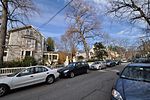Theodore W. Richards House
Harvard SquareHistoric district contributing properties in MassachusettsHouses completed in 1900Houses on the National Register of Historic Places in Cambridge, MassachusettsNRHP infobox with nocat ... and 1 more
National Historic Landmarks in Cambridge, Massachusetts

The Theodore W. Richards House is a National Historic Landmark at 15 Follen Street in Cambridge, Massachusetts. Built in 1900, it was the home until his death of Theodore William Richards (1868-1928), the first American to be awarded the Nobel Prize in Chemistry. Richards was a leading experimental chemist of his day, measuring (as precisely as instruments of the day permitted) the atomic weights of a large number of elements. He was also responsible for the growth of Harvard University's graduate chemistry program to one of the finest in the nation. The house was designated a National Historic Landmark in 1976.
Excerpt from the Wikipedia article Theodore W. Richards House (License: CC BY-SA 3.0, Authors, Images).Theodore W. Richards House
Follen Street, Cambridge
Geographical coordinates (GPS) Address External links Nearby Places Show on map
Geographical coordinates (GPS)
| Latitude | Longitude |
|---|---|
| N 42.378777777778 ° | E -71.122111111111 ° |
Address
Follen Street 15
02163 Cambridge
Massachusetts, United States
Open on Google Maps










